IDEX Online Research: Polished Diamond Prices Stable in May, With Upward Move at Month-End
June 04, 12
(IDEX Online) – Polished diamond prices remained stable during May. While the May monthly average of the IDEX index was basically flat with the average for April, the averages don’t tell the full story.
Polished diamond prices showed a modest spike during the final week of the month, according to the IDEX Online Global Polished Price Index. The price spike – just under one percent – came just as diamantaires were leaving for the important JCK show; an upward polished diamond price move often occurs just prior to important trade shows.
Based on news from the JCK show, it appears that diamond demand remains solid among American jewelers, so prices could move up in the post-show period.
Price Action Mixed by Diamond Size
Most of the key polished diamond sizes posted lower prices in May, when compared to April prices. The significant exceptions: five-carat round diamond prices were up by nearly two percent, and half-carat diamonds eked out a price increase of three-tenths of one percent during the month.
The graph below summarizes the daily movement of polished diamond prices during May based on the IDEX Online Global Polished Price Index, widely accepted as the most accurate and most transparent indicator of global polished diamond prices.
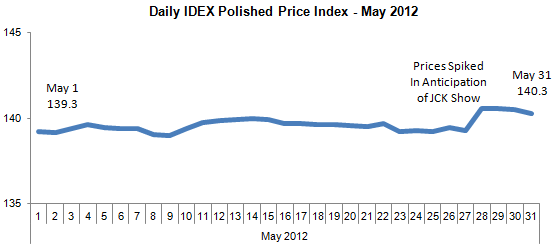 Source: IDEX Online |
Polished Diamond Prices Trending Flat for Eight Months
After peaking during the summer of 2011, global polished diamond prices slipped during the third calendar quarter, and flattened during the fourth quarter of 2011 based on monthly averages.
Since the beginning of 2012, polished diamond prices have remained relatively flat, as the graph below illustrates. If the pre-JCK Show polished diamond price increase holds, it would be the first notable increase in diamond prices in about eight months, as the graph below illustrates.
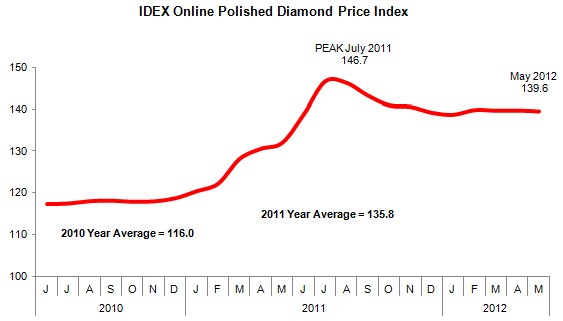 Source: IDEX Online |
The graph below shows how sharply diamond price momentum has slowed on a month-to-month basis since mid-summer 2011. After rising by more than five percent per month in June and July 2011, prices slipped in the third quarter, and have been basically flat since the beginning of 2012.
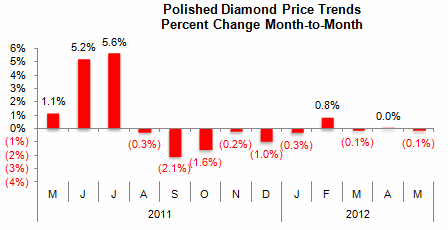 Source: IDEX Online |
Final Demand Remains Stable
There are no significant large global markets where diamond and jewelry demand is exceptionally strong, nor has demand totally collapsed in any markets recently.
· Europe seems destined to slip back into a recession, and consumers have already begun to cut spending. European diamond demand represents just under 15 percent of total global diamond and diamond jewelry sales.
· U.S. economic growth remains lackluster, and jewelry sales growth slowed in the first quarter of 2012 to a mid-single digit level from a string of double-digit quarterly gains in 2011. Recent economic news from the U.S. has been disappointing, but the long-term trend remains positive. Diamond demand in the U.S. market represents nearly 40 percent of the global diamond market.
· China’s diamond demand remains solid, but its blazing economic growth during 2010 and 2011 slowed earlier this year. While the latest OECD forecast suggests that China’s economic growth is about to begin recovering, we expect diamond jewelry demand to pause from its previously torrid pace until it is clear that strong economic growth is sustainable in the country. China represents just over 10 percent of global diamond demand.
· India’s demand for diamonds seems to be in a holding pattern currently, though the long-term prospects are very bright. India’s diamond demand represents about 12 percent of global demand.
· Japan’s diamond demand is showing some strength, but since it is only 8 percent of global demand, it is not having a notable impact on diamond prices.
Until global economic conditions solidify and accelerate, it is unlikely that polished diamond prices will begin to move substantially higher. We note that price trends for most other commodities used in jewelry – precious metals and colored gemstones – have been relatively flat since the beginning of the year, with no energy to move higher until economic conditions improve.
Year-to-Year Polished Diamond Prices: Gains Clearly Slowing
Polished diamond prices in May 2012 rose 5.7 percent from the same month a year ago, based on average prices during the month. This is the third consecutive month that year-to-year price comparisons have fallen to single-digit levels.
The graph below shows that May’s polished diamond price increase of 5.7 percent is well below prior months’ trends. Further, it reflects a slowing year-to-year price comparison.
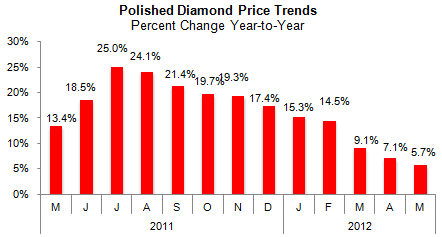 Source: IDEX Online |
Diamond Prices: Most Sizes Post Lower Prices In May
Prices edged lower for almost all of the major polished diamond sizes in May versus April 2012.
· Prices for all diamonds four-carat and below were either about flat or down somewhat, with the exception of one-half carat diamonds, which eked out a modest gain.
· Five-carat polished diamond prices continued to rise sharply in May, when compared to April. This is the reversal of March’s trend of sharply lower prices for five-carat diamonds, but a continuation of trend in April, when five-carat stones showed a large increase in price. Trading of these stones is thin, and prices tend to bounce around.
The graph below summarizes month-to-month price changes for polished diamonds by size.
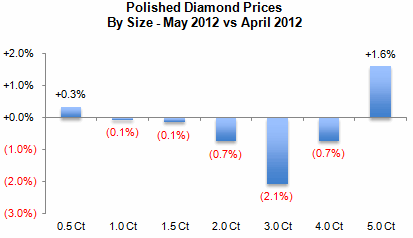 Source: IDEX Online |
· On a year-over-year comparison, polished diamond prices in May were mostly ahead for the key diamond sizes, when compared to May 2011. Prices for most size stones rose by mid-to-high single percentage levels, with the notable exception of three-carat diamonds. This is mostly a tough comparison against last year: three-carat diamonds popped in price during April 2011, and then began trending higher in subsequent months.
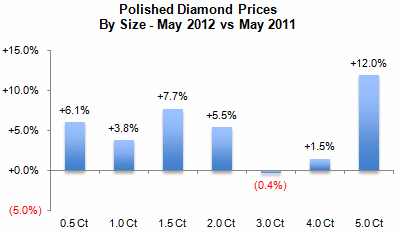 Source: IDEX Online |
Long Term Trend Shows Bouncing Prices in 2011 and Early 2012
After rising slowly since mid-2010, prices of most round polished diamond – by carat size – have shown a downward bias for the past nine months, with the exception of February, when it appeared that prices were headed higher. May prices: essentially, polished round diamond prices have been bouncing around on a monthly basis since mid-2011, with no significant net increase or decrease, as the graph shows.
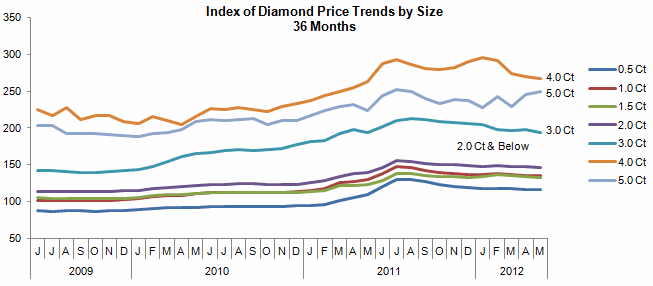 Source: IDEX Online |
Outlook: No Major Negatives On the Horizon
Overall, it appears that there are more positive factors than negative factors which will affect diamond prices, both during 2012 and beyond:
· Good news: most economists are predicting that 2012 economic gains in the U.S. will modestly outpace 2011’s tepid growth. There is a high correlation between economic cyclicality and diamond demand. Therefore, if the U.S. economy posts improvement in 2012, it is reasonable to assume that polished diamond demand will strengthen in this market. Recent economic news from the U.S. has been disappointing, but a negative trend has not yet been established.
· Better news: early indications suggest that diamond demand at the JCK show is relatively solid.
· The offset: the OECD Composite Leading Economic Indicators for the Euro Area, continue to point to below-trend economic growth.
Longer term, polished diamond prices appear to be headed higher due to several factors within the diamond market:
· Emerging markets, including China and India, are poised for solid long-term growth. As consumer wealth builds in these markets, shoppers will be spending more on jewelry.
· Rough diamond supplies appear to be flat, at best, for the next decade or longer. With flattish supply, but rising demand, the forces of capitalism will push diamond prices higher.
The table below summarizes the average price of polished diamonds, using the IDEX Online Polished Diamond Price Index. The pre-recession peak for diamond prices occurred in August 2008 (box). As expected, polished diamond prices were weak during the “Great Recession” which officially ended in mid-2009. Unfortunately, polished diamond prices lagged the general economic recovery, and did not begin to show an upward bias until early 2010. The new, latest record price level (red box) occurred in July 2011. After slipping, prices have remained relatively stable since October 2011, well above the pre-recession peak.
 Source: IDEX Online |